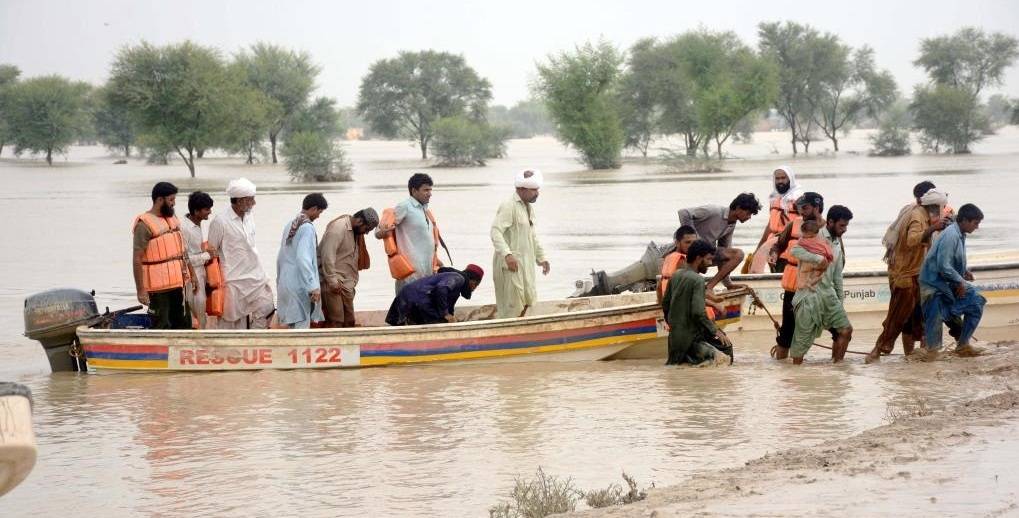The multifaceted menace of climate change poses a profound threat to Pakistan’s stability, economic prosperity, and the overall well-being of its populace. This exploration delves into the intricate interplay between climate change and Pakistan’s existential challenges, underscoring the urgency for strategic interventions … writes Dr Sakariya Kareem
Climate change as a worldwide discourse encompasses the three significant emergencies that are climate change, environmental degradation, and pollution. This article delves into the crisis caused by climate change and its existential impact on Pakistan. Pakistan, as a country, is under the severe effects of global climate change.
Pakistan stands at a pivotal moment, facing an existential crisis that transcends conventional security worries. The multifaceted menace of climate change poses a profound threat to the nation’s stability, economic prosperity, and the overall well-being of its populace. This exploration delves into the intricate interplay between climate change and Pakistan’s existential challenges, underscoring the urgency for strategic interventions.
Nowadays, Pakistan is facing the dire consequences of climate change and an imminent water crisis. The report published by the United Nations Intergovernmental Panel on Climate Change (IPCC) in August 2021 focuses on the irreversible nature of global warming and devastating summers marked by wildfires, extensive cropland damage, and heat waves.

One critical aspect is the nexus between climate change and water scarcity, intricately linked to Pakistan’s agrarian economy heavily reliant on the Indus River. Escalating impacts, such as erratic rainfall patterns and glacial melt, have led to water scarcity, significantly affecting agricultural productivity.
The melting glaciers of Pakistan are evidence of the climate crisis, as the country is highly dependent on glacier-fed rivers, particularly the Indus River. The Indus River water flows between two countries, India and Pakistan, and a significant volume of water is supplied to Pakistan. The threat looming over Pakistan due to the melting of glaciers in the Pakistan River Valley system is evident, and it is time for the government to take proactive measures and introduce regulations to address this challenge. The IPCC report predicts that if the current situation continues, then the Water shortage will happen in Pakistan by 2050. Further, the government is not making sincere efforts to generate electric energy from renewable sources and still relies mainly on nonrenewable sources of energy.
Moreover, the increasing frequency and intensity of extreme weather events, from floods to droughts, have become pronounced in Pakistan. These events not only displace communities but also exacerbate existing socio-economic disparities, necessitating a nuanced approach to bolster resilience and safeguard human security, particularly for vulnerable populations.
People of Pakistan are displaced due to environmental challenges such as untimely rains, floods, landslides and heat waves, which are causing severe impacts on the country’s human lives, agriculture and infrastructure. Large-scale deforestation along the Karakoram Highway led to the landslide. Massive infrastructure loss has happened, including the destruction of bridges and networks of roads, leading to the shutting down of the economic corridor that is responsible for trade with China.
The timber mafias exacerbate the deforestation challenge. The Pakistani government, under Imran Khan’s leadership in 2018, launched a Million Tree Plantation Drive. This initiative of planting new trees cannot replace the old forest that took several years to grow and maintain the ecosystem.
Another important factor or rather a challenge of Climate Change is the pollution near the Gwadar Port. The significant role of the port cannot be denied in Pakistan’s economic development. However, it is also shadowed by emerging environmental challenges, particularly impacting critical infrastructure like the Gwadar International Airport. The rapid industrial expansion in Gwadar has brought economic opportunities but simultaneously escalated pollution levels. The discharge of pollutants from industrial activities and shipping operations has contributed to the deterioration of air quality in the region, directly threatening the safety of flights operating at Gwadar International Airport.
The close proximity of Gwadar Port to the airport raises legitimate concerns regarding the adverse impact of air pollution on essential aviation infrastructure. Particulate matter and chemical residues from pollutants have the potential to compromise crucial elements such as navigational aids, communication systems, and runway surfaces. Stringent measures are imperative to ensure the sustained operational integrity of the airport. Additionally, poor air quality, a byproduct of pollution, significantly diminishes visibility, a critical factor for safe takeoffs and landings. This reduction in visibility increases the risk of accidents and poses challenges for pilots during essential phases of flight, underscoring the urgency to mitigate pollution in the airport vicinity.
Furthermore, the adverse effects of air pollution extend beyond infrastructure concerns to directly impact the health of aviation personnel, encompassing pilots, air traffic controllers, and ground staff. Prolonged exposure to pollutants poses a risk to respiratory health, compromising the well-being of those entrusted with ensuring the safe operation of flights. Another crucial challenge includes an emerging issue related to the overcrowding of birds attracted to sea pollution. The contaminated waters serve as a magnet for diverse bird species seeking food resources. While this addresses immediate ecological concerns, the concentration of birds introduces consequential risks to air safety.
The geographical location of Pakistan and its dependence on agriculture is making the country vulnerable to climate change. It is estimated that a reduction of 18 to 20% in Pakistan’s GDP by 2050 would occur due to environmental degradation, pollution, and climate-related issues. The problems get exacerbated by potential potable water scarcity, the surge in the prevalence of diseases, and floods. Pakistan’s existing national policies, such as the National Climate Change Policy and Pakistan Vision 2025, have failed to tackle and mitigate the effects of climate change.
In conclusion, Pakistan finds itself entangled in an existential crisis with climate change permeating every facet of its environmental, economic, and social fabric. A comprehensive and proactive approach is imperative to address the multifaceted challenges posed by climate change and secure the nation’s future. Regrettably, the prevailing trajectory, marked by inadequate governmental action, paints a bleak picture for Pakistan’s environmental sustainability. A comprehensive approach is necessary to address the various challenges posed by climate change.

